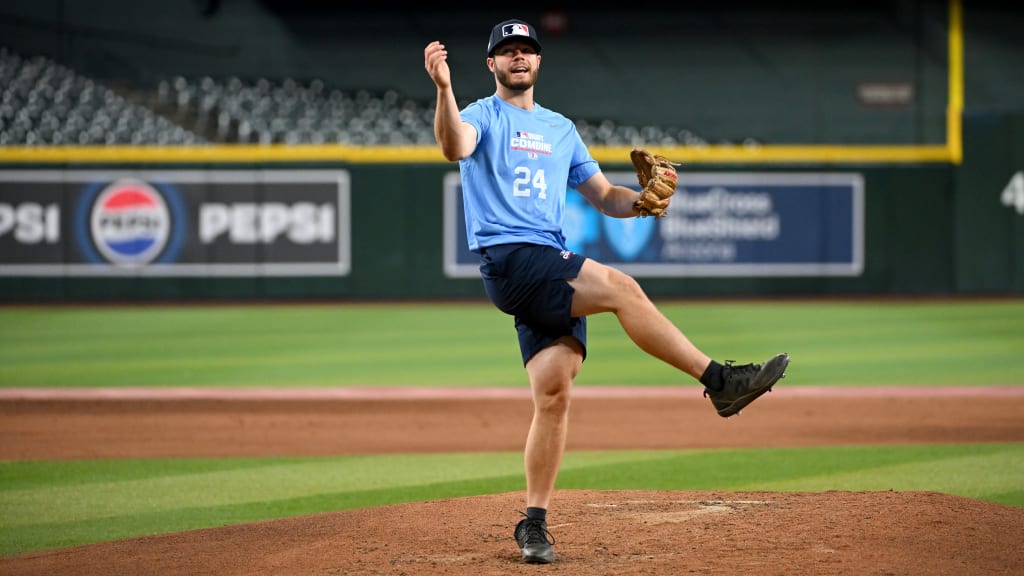PHOENIX -- “You can know everything in the world, sport, but the only way you’re finding that one out is by giving it a shot.”
Robin Williams’ character in Good Will Hunting offers the above advice to an MIT janitor/genius played by Matt Damon. In the context of the film, Williams is imparting wisdom to Damon’s fictional character as it pertains to a love interest; but in the context of the life of Mason Estrada, an actual aerospace engineering major from MIT, the shot Estrada is taking is on something that he loves -- baseball.
Estrada grew up in Covington, La., and before anything else, he loved being outdoors. Hunting. Fishing. You name it, whatever got him outside and active, he was game. It wasn’t until around age 12, when he reeled off a spate of homers consecutively, that it dawned on him that he was pretty good at that baseball thing, too.
While it would make sense that a kid who got a 36 superscore on his ACT (out of 36) and a 34 composite would have MIT on his short list of places to study, the way Estrada wound up on campus in Cambridge, Mass. -- at a school with an acceptance rate that is south of five percent -- was more a game of happenstance.
“One of my dad's best friends growing up, one of his good friends' father was the [athletic director] at MIT for a while, so they got me in touch with him and he got me in touch with the baseball coaches and kind of put MIT on my radar because I didn't really think of it as an option for me,” Estrada said.
“It was always kind of school first. I was good at baseball when I was younger, I was not elite. I only had a couple of small looks from D-I programs, a lot of JUCO and D-II, D-III looks, and so no schools that were really interested in me that were worth giving up an MIT degree. So that's why I ended up going to MIT. But it was definitely a juggle focusing on school, focusing on baseball -- I just had to make sure I kept my priorities straight.”
But while Estrada was establishing himself on the field during high school, he was dealing with loss away from it. His father, Mike, a revered member of the Knights Knation community and a former United States Marine, passed away during Estrada's junior year following a battle with cancer. Estrada has dealt with the disease at other times as well -- his girlfriend’s younger sister overcame childhood cancer -- and has used that exposure as motivation.
“I have a very, very strong passion for the outdoors, hunting and fishing, and unfortunately, cancer has been a pretty big part of my life in a negative way, but I think there's a reason for that," Estrada said. "I think I'm being called to help kids who are in not-so-great situations have peaceful moments and be able to experience nature and everything it has to offer.”
While Estrada may be one of the most interesting stories in this year's Draft class, that doesn’t get you invited to the Draft Combine. A 96 mph fastball helps.
More on the Draft Combine:
- Day 1 standouts | Day 2 standouts
- Could Pierce be next Witt Jr.? | Sabathia's son can slug
- Hometown power hitter's record exit velos
- After leaving home at 14, Gamble ready for pros
- Worley's crazy pitch grip | The return of Walsh
- 10 prospects to watch | Participants
- Preview | Attendees announced | Complete coverage
Estrada was invited to the fifth-year event in Phoenix, where he showed off the explosive arsenal that led to him compiling 66 strikeouts across 40 2/3 innings last season with a 2.21 ERA, all without allowing a home run. In addition to sitting consistently at 94-96 mph with his heater while on a big league mound with all eyes on him, Estrada was ripping off 84-87 mph slider/cutter hybrids that registered as high as 2700 RPMs.
If that just sounds like the type of repertoire that could play at a higher collegiate level, you’d be thinking along the lines of the Tennessee Volunteers, who have secured Estrada as a transfer commit for the 2026 season should he not sign out of this year’s Draft.

Pro baseball was never really on Estrada’s radar until his freshman year at MIT when he reared back, fired and got a radar gun reading of 95 mph. There aren’t many humans walking the earth capable of that, let alone ones that willingly enlist in a thermodynamics course (Estrada cited that as his most challenging class, lest we think it all comes easily to the right-hander). But while the infrastructure for going pro in electrical engineering or mathematics is certainly available at MIT, baseball isn’t as ready-made.
“Our batting cages are retractable -- you pull them up with the pulley and they're in the gym, so that was a struggle,” Estrada said. “The mounds would slide all over the place because there's no traction and hitters would be sliding on the gym floor or the mat would slide. So definitely some unique challenges playing Division III baseball.”
But that hasn’t stopped Estrada in the slightest.
“My mom has been very supportive of what I thought was best,” Estrada said. “She knows I've always made calculated decisions. She'd be much more nervous if I was giving up the degree, but I'm making sure that I keep the ability to go back and get my degree later whenever I'm done with baseball.”
What started with a fascination with paper airplanes as a child has taken Estrada to one of America’s most prestigious institutions. But that same child fascination with baseball has always held its pull.
It’s baseball now, jet engines and distributed propulsion later.
